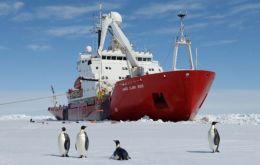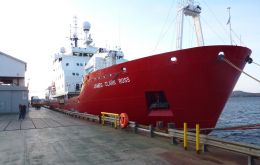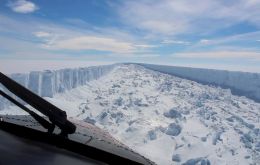MercoPress. South Atlantic News Agency
Tag: Antarctica Larsen C ice shelf
-
Saturday, April 16th 2022 - 08:06 UTC
Trying to understand the melting process of the largest ice shelf in Antarctica

A new study by scientists from British Antarctic Survey (BAS) has used computer modeling to rank the factors responsible for the Larsen C ice shelf melt according to their severity. The review is an important contribution to the understanding of the largest remaining ice shelf on the Antarctic Peninsula.
-
Friday, March 9th 2018 - 04:38 UTC
Plan B for RRS James Clark Ross mission to Antarctica Larsen C Ice Shelf

Heavy sea ice conditions have thwarted a science mission from reaching the Larsen C Ice Shelf in Antarctica from which a large iceberg broke off in July 2017. A team of scientists, led by British Antarctic Survey (BAS), are travelling on board the RRS James Clark Ross. Sea ice, up to 4-5 meters thick, has made progress for the ship very slow and on 28 February) the ship’s captain made the difficult decision not to continue.
-
Friday, February 23rd 2018 - 11:20 UTC
BAS team leaves Falklands to explore Antarctica marine ecosystem hidden for 120.000 years

A team of international scientists led by the British Antarctic Survey set off on Wednesday to explore a mysterious marine ecosystem that has lain hidden under an ice shelf for up to 120,000 years.
-
Tuesday, February 13th 2018 - 08:30 UTC
BAS targets Antarctica marine ecosystem under calved iceberg: nine-country team takes off from Falklands

A team of scientists, led by British Antarctic Survey (BAS), heads to Antarctica this week (14 February) to investigate a mysterious marine ecosystem that’s been hidden beneath an Antarctic ice shelf for up to 120,000 years. The iceberg known as A-68, which is four times of London, calved off from the Larsen Ice Shelf in July 2017.
-
Thursday, July 13th 2017 - 08:53 UTC
Huge iceberg breaks free from the Antarctica Larsen C ice shelf

An iceberg the size of Delaware has broken free from an Antarctic ice shelf, leaving the rest of the shelf vulnerable to collapse and serving as a harbinger of future sea-level rise that could pose a serious threat to coastal communities such as the Falkland Islands.
-
Thursday, July 6th 2017 - 04:07 UTC
Antarctica Larsen C ice shelf about to spawn huge berg. In pieces it could reach as far as Falklands

Antarctica’s Larsen C ice shelf deep crack continues to cut across the ice, leaving a huge chunk clinging on. When it eventually gives way, one of the largest icebergs on record will be set adrift, and whole or in pieces, ocean currents could drag it north, even as far as the Falkland Islands. And if so it could pose a hazard for ships in Drake Passage.
